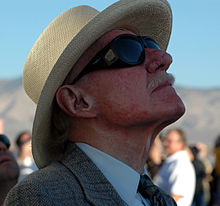"Much of Cooper's fireproof confidence was based on the fact that he was a 'Natural born stick and rudder man' as the saying went." The Right Stuff, Tom Wolfe (1979).
Noting the passing of R. A. "Bob" Hoover, pilot.
There are two kinds of people - those who look up when an aircraft flies overhead, and those who do not. For the latter, they missed something.
Stick and rudder... It means that a pilot is relying on the controls of the airplane that they manipulate. No computers, no autopilot, no enhanced stability software. Hands and feet, flaps and ailerons. Cool, calm, and steady.
Robert Anderson Hoover was a pilot, learning to fly in Nashville. He paid for lessons out of his own pocket working in a grocery store. When WWII broke out, he enlisted. Assigned to a unit equipped with British Spitfires, he was shot down on his 59th mission. After almost a year and a half in a POW camp he escaped. He stole a German FW-190 (an aircraft type he'd never flown), got it airborne and headed for freedom. He was twenty-three years old.
Chuck Yeager broke the "Sound Barrier" in the Bell X-1 in October, 1947. His back-up and chase pilot? Bob Hoover.
Over a period of years during jet propulsion's adolescence, Hoover flew a progression of air-breathing American military aircraft, in addition to rocket planes. He went to Korea and taught pilots to fly the new and idiosyncratic F-86. While there he flew it in ten bombing missions.
It would be easy to write that he was "best known" as an airshow performer. That is true, as far as it goes, for the several million people who watched him over the course of forty years of exhibition flying. His routines in a P-51 Mustang called "Ole Yeller" (it was yellow...duh) were breathtaking. He also flew that aircraft at the Reno races, the "pace car," as it were, that started the heats.
His skill was most at show center when he took off in a Rockwell Shrike Commander light twin business airplane. Propeller-driven, piston engines, meant to safely and comfortably fly executives. The type, in fact, had been used as "Air Force One" periodically by Dwight Eisenhower. In Hoover's hands, it was an aerobatic spectacle. Aside from the usual display of upside down, inside out...over and under, he would shut off the engines and continue the routine. The plane whistled, the crowd oohed and ahhed... Hoover brought it to a stop at show center, a perfect display of aviation physics. Several times, my family and I were lucky enough to be there, awestruck.
He was also known to knock back a few. He knew all of the big names in aviation's coming-out era, no doubt having joined them in toasts to their lost friends. Last month he joined the departed souls, lucky men and women who have learned to control winged aircraft in flight.
There are awards and accolades galore for a man like Bob Hoover. One stands above all of the others. "He was the best stick and rudder man I ever saw," Jimmy Doolittle said. Yes, that Jimmy Doolittle, a pretty fair pilot himself.
You've slipped the surly bonds of Earth, Mr. Hoover. Thanks for everything. Fly high.

No comments:
Post a Comment